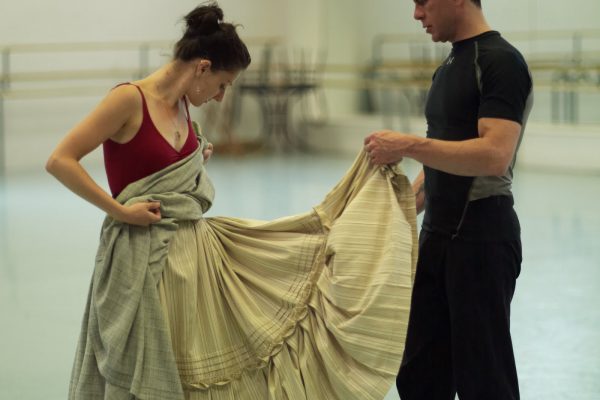Canada’s Royal Winnipeg Ballet tumbled down the rabbit hole this spring with its highly anticipated world premiere of Shawn Hounsell’s “Wonderland”. The five-show run held at the Centennial Concert Hall from March 9th through 13th preceded an eight-city tour of Western Canada, with the contemporary ballet presented from April 28th through 30th at Ottawa’s National Arts Centre Prairie Scene festival celebrating arts and culture from Manitoba and Saskatchewan.
Born in Birch Hills, Saskatchewan, Hounsell began his dance training as a theatre major at the University of Saskatchewan before being accepted to the RWB School Professional Division in 1986. He immediately joined the company on graduating four years later, and subsequently performed with Les Grands Ballets Canadiens de Montréal from 1995 until 2003. As a recipient of the 1997 Clifford E. Lee Award, Hounsell’s choreography has been hailed for its theatricality and has been performed by numerous Canadian companies including the RWB, Les Grands Ballet Canadiens de Montréal, Les Ballet Jazz de Montréal, Le Jeune Ballet du Québec and Festival Dance Company.
“Wonderland”, notably Hounsell’s first full-length story ballet, is a fantastical, breathtakingly ambitious work underscored by pop culture references and a contemporary idiom. Inspired by Lewis Carroll’s beloved nineteenth-century tale, the Montréal-based choreographer has added his own imaginative twists as well as re-visioning familiar characters who all make an appearance: Alice (Jacelyn Lobay); Caterpillar (shared by: Amanda Green, Dmitri Dovgoselets, Amar Dhaliwal and Tristan Dobrowney); Duchess (Eric Nipp); and narcoleptic Dormouse (Yayoi Ezawa). The ballet also marks retiring principal dancer Tara Birtwhistle’s last character role as the wildly outrageous Queen of Hearts. The two-and-a-half hour show unfolds as a memory, punctuated by a series of voiceovers that begins with a grown-up Alice recounting her story as a dream.
The eye-popping spectacle in “Wonderland” created through multimedia projections by Jimmy Lakatos (Turbine) and set design by Guillaume Lord is unprecedented for the company. A lush forest morphs into a whirling, psychedelic vortex into which Alice falls. Projected images of the young heroine magically grow sky high and shrink into miniature as she hurtles deeper into the rabbit hole. Despite the undeniably dazzling visual effects however, I felt the steady barrage of images often overwhelmed the choreography, becoming cumulatively exhausting by the end. Ironically, the dancing played second fiddle to the visual effects and I secretly longed for the climactic danced showdown between Alice and the Queen that would bring reprieve. Using signs to instruct the audience when to applaud is also highly problematic, and only made me feel as befuddled as Alice by the end.
Technically strong, the ballet features Hounsell’s own dialect of angular movement vocabulary, including pointe work, flexed feet, body isolations and inventive backward flips. At breakneck speed, the ballet flowed without a hitch although several scenes, such as Alice’s encounter with the Duchess felt overly long. Many characters — particularly Alice — weren’t adequately fleshed out and too much frantic activity distracted from the increasingly bizarre storyline. While Alice may encounter a host of strange characters during her journey, I never sensed her true emotional trajectory as she descends into Wonderland’s madness — and then returns to comforting reality.
Hounsell has added many witty touches and even pokes fun at classical ballet itself. During a quick tempo segment akin to a carnival funhouse where characters slam through one door only to emerge through the next (accompanied by a guffawing laugh track), a snowy white ballerina suddenly appears. A gorilla chewing a banana also pops in, as Alice and the White Rabbit are chased by the cartoonish Loony Toons who serve as a type of Greek chorus. A TV-style Jeopardy board, golf games instead of croquet, breaking news ticker tapes, a Las Vegas road sign and a cheesy, faux-glamour Strauss waltz performed by pink flamingoes throw campy nods to pop culture. Hounsell seems to suggest that these forms of escapism are our own modern day Wonderlands, a provocative idea that I wanted to see articulated more forcefully.
Several sections provide much needed repose. The eloquent “A Garden of Live Flowers” scene performed by eight bare-footed female dancers in white filmy skirts and translucent headdresses flowed with suspended grace. The hookah pipe–puffing Caterpillar’s deliciously hallucinogenic quartet truly mesmerized, with the three male dancers sensually lifting Green (as the insect’s head) against projected swirls of blue smoke.
The character of Gryphon was performed by two dancers (Jo-Ann Sundermeier and Amar Dhaliwal) whose pas de deux accompanied by solo harp bled into a lyrical solo by Dovgoselets as Mock Turtle. This particular transition spoke with artful simplicity, where less became much, much more.
Overall, the company of twenty-six dancers displayed impressive conviction, pushed well beyond their comfort zones by Hounsell. The evening was marked by several stand-out performances:
Birtwhistle sells her cranky, cigarillo-smoking Queen of Hearts for all she’s worth, whether barking out orders to Wonderland’s fantastical denizens or tearing a strip off the Vegas-showgirl Flamingoes through a megaphone. A short film segment that showed her trooping backstage added furthering layering to her larger-than-life character, depicted as an aging, former silent movie star.
Principal Vanessa Lawson excels as the hyperkinetic/dominatrix March Hare, clad in tight black Capri pants with riding whip in hand. Her polyglot spluttering during the Mad Hatter’s crazy tea party bristled with energy while showing a completely new side to this gifted artist.
Acting as Alice’s guide and catalyst for the story, soloist Yosuke Mino’s funky White Rabbit is as crisp as his rabbit-white cargo pants. I felt his poignant relationship with Alice – as her protector – might have been further developed with their final pas de deux, which was all too fleeting.
Kudos to RWB music director Tadeusz Biernacki for leading the Winnipeg Symphony Orchestra through Canadian composers John Estacio and Brian Current’s complex electro-acoustic score. Costume designer Anne Armit created over forty breathtaking costumes, while lighting designer Hugh Conacher added his own dramatic flair.
The company renowned for its “Prairie freshness” is to be commended for supporting new creation – the lifeblood of any arts organization. Over the course of its illustrious seventy-one-year history, it has continued to nurture its homegrown artists while offering a steady diet of ambitious contemporary ballets to its loyal audiences.
Yet amid all the high-tech chaos and confusion, what was starkly missing in “Wonderland” – ironically – was a sense of wonder. During the final voiceover, older Alice declares she would have been lost without “that dear Rabbit,” but it all, sadly, rings hollow. The show will invariably tighten up; perhaps necessary cuts will be made. But for now, even the White Rabbit couldn’t save Alice — or this ballet — from the spinning vortex.
Tagged: Ballet, Performance, MB , Winnipeg





